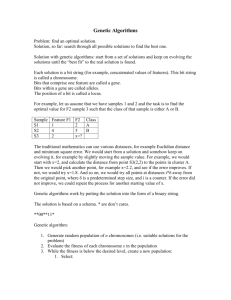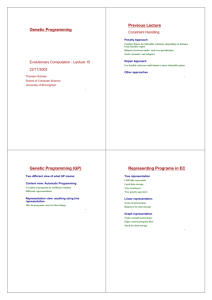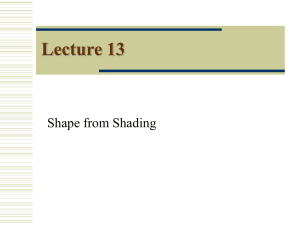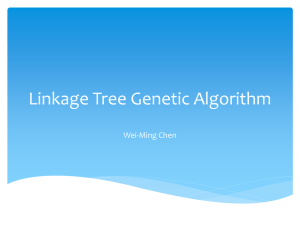Application of Crossover Factor on FPSGA in Optimization Problem Kamil Karmila
advertisement
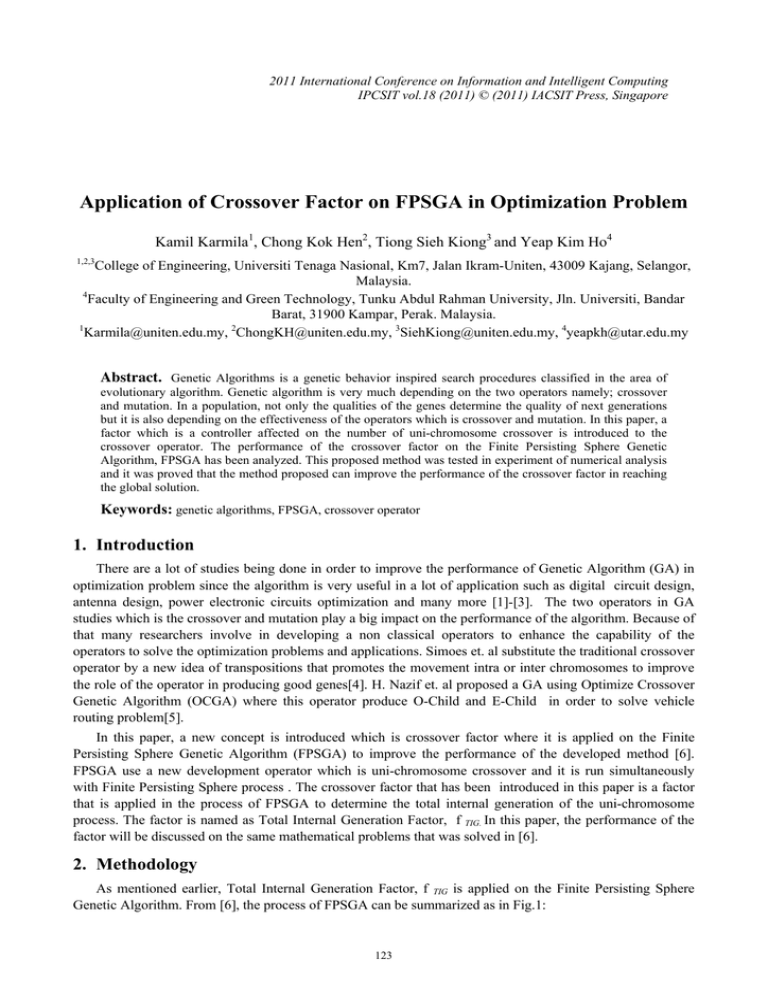
2011 International Conference on Information and Intelligent Computing IPCSIT vol.18 (2011) © (2011) IACSIT Press, Singapore Application of Crossover Factor on FPSGA in Optimization Problem Kamil Karmila1, Chong Kok Hen2, Tiong Sieh Kiong3 and Yeap Kim Ho4 1,2,3 College of Engineering, Universiti Tenaga Nasional, Km7, Jalan Ikram-Uniten, 43009 Kajang, Selangor, Malaysia. 4 Faculty of Engineering and Green Technology, Tunku Abdul Rahman University, Jln. Universiti, Bandar Barat, 31900 Kampar, Perak. Malaysia. 1 2 Karmila@uniten.edu.my, ChongKH@uniten.edu.my, 3SiehKiong@uniten.edu.my, 4yeapkh@utar.edu.my Abstract. Genetic Algorithms is a genetic behavior inspired search procedures classified in the area of evolutionary algorithm. Genetic algorithm is very much depending on the two operators namely; crossover and mutation. In a population, not only the qualities of the genes determine the quality of next generations but it is also depending on the effectiveness of the operators which is crossover and mutation. In this paper, a factor which is a controller affected on the number of uni-chromosome crossover is introduced to the crossover operator. The performance of the crossover factor on the Finite Persisting Sphere Genetic Algorithm, FPSGA has been analyzed. This proposed method was tested in experiment of numerical analysis and it was proved that the method proposed can improve the performance of the crossover factor in reaching the global solution. Keywords: genetic algorithms, FPSGA, crossover operator 1. Introduction There are a lot of studies being done in order to improve the performance of Genetic Algorithm (GA) in optimization problem since the algorithm is very useful in a lot of application such as digital circuit design, antenna design, power electronic circuits optimization and many more [1]-[3]. The two operators in GA studies which is the crossover and mutation play a big impact on the performance of the algorithm. Because of that many researchers involve in developing a non classical operators to enhance the capability of the operators to solve the optimization problems and applications. Simoes et. al substitute the traditional crossover operator by a new idea of transpositions that promotes the movement intra or inter chromosomes to improve the role of the operator in producing good genes[4]. H. Nazif et. al proposed a GA using Optimize Crossover Genetic Algorithm (OCGA) where this operator produce O-Child and E-Child in order to solve vehicle routing problem[5]. In this paper, a new concept is introduced which is crossover factor where it is applied on the Finite Persisting Sphere Genetic Algorithm (FPSGA) to improve the performance of the developed method [6]. FPSGA use a new development operator which is uni-chromosome crossover and it is run simultaneously with Finite Persisting Sphere process . The crossover factor that has been introduced in this paper is a factor that is applied in the process of FPSGA to determine the total internal generation of the uni-chromosome process. The factor is named as Total Internal Generation Factor, f TIG. In this paper, the performance of the factor will be discussed on the same mathematical problems that was solved in [6]. 2. Methodology As mentioned earlier, Total Internal Generation Factor, f TIG is applied on the Finite Persisting Sphere Genetic Algorithm. From [6], the process of FPSGA can be summarized as in Fig.1: 123 1.0 2.0 2.1 2.2 2.4 2.5 3.0 Start For i:=1 to L do Generate initial population Generate 1 random value, x (Number of internal generation) For j:= 1 to x do Execute uni-chromosome crossover First evaluation Mutation Second evaluation Take out the best answer 4.0 End 2.3 Figure 1. Pseudocode of FPSGA In this paper, the same uni-chromosome crossover is applied. However a new factor, f TIG is injected to the crossover operator in order to increase the probability of fast convergence which can help to improve the efficiency of the processing time in a system. Here, the number of internal crossover is restricted to the factor applied instead of running it uncontrolled [6]. It means that the number of internal crossover can be controlled when applying the factor and reducing the processing time. This method is also applying the concept of Finite Persisting Sphere to maintain the diversity of the great population. The process of the proposed method is represents in the psuedocode in Fig.2. 1.0 Start 2.0 Generate initial population 3.0 Evaluation 4.0 For i:=1 to Total number of generation 4.1 Roulette Wheel Selection 4.2 Execute Finite Persisting Sphere process 4.2.1 Applying Total Internal Generation Factor, f TIG 4.2.2 Generate number of internal crossover, X depending on the value of f TIG 4.2.3 for j:=1 to X do 4.2.3.1 Execute unichromosome crossover 4.2.3.2 Evaluate fitness function end 4.3 Mutation 4.4 Evaluate fitness function 5.0 Take out the best result 6.0 End Figure 2. Pseudocode of FPSGA with f TIG In this paper the same mathematical problem in [6] is considered for the experimental purpose. The equation is used to find the maximum number can be produced from the range of x1 and x2 The equation for the optimization problem is as follows: f(x1,x2) = 21.5 + x1 sin (4πx1) + x2 sin (20 πx2) (1) where -3.0 ≤ x1 ≤ 12.1 124 4.1 ≤ x2 ≤ 5.8 The funnction within the range given above crreates multi local l optimum ms. From [6]], the global optimum forr the problem m is 38.84177 where the value of x1=11.625 and d x2=5.725. The GA paarameters ap pplied in thee experiment are shown inn Table 1. TABLE I. RISTICS APPLIE ED IN THE EXP PERIMENT BY APPLYING A N FACTOR , F CHARACTER TOTTAL INTERNALL GENERATION TIG. Populaation Size Lengthh of Chromosom me Probabbility of Crossovver Probabbility of Mutatioon Numbeer of Generationns 50 33 1.0 0.8 100 3. Experriment Reesults 8 x(2) 6 4 2 0 -3 2 7 12 x(1) (a) FPSGA A with internall generation 8 x(2) 6 4 2 0 -3 2 7 12 x(1) (b) FPSGA F with external e and internal generaation Figure 3. Chrom mosome distrib bution in the solution pool Fig. 3(aa) and (b) shoow the chrom mosomes disttribution in solving s the opptimization pproblem wheen the f TIG iss applied. In Fig. F 3, the innternal generration means that the deveeloped GA is run until it finish the prrocess of 4.22 (refer to psuuedocode in Fig. 2) withhout finishinng the wholee process of the developeed GA . Thiis is done inn order to studdy the behavvior of the unni-chromosom me crossoverr and Finite Persisting P looop. FPSGA with w externall and internall generation in the processs is means that t the whole process iss run to deterrmine the glo obal solutionn of the problem. o to imprrove the capaability of FPS SGA for fastt The totaal internal geeneration facttor, fTIG is inttroduced in order convergencee. Individualls or chromoosomes with great g quality y are very useeful to ensurre that the local optimum m can be reachhed in a fast way. w Fig. 3a represents thhe chromosom mes distributtion of one population whhere only inteernal generattion is run. Itt shows that 24 2 chromosoomes from the total of 44 chromosomees are generaated betweenn 10 to 12.1 for fo x1 and 4.1 to 5.8 for x2 where the area a of globaal optimum exists. e It meaans that by appplying the fTIG, 57 perceents from thee total chrom mosomes com mprise of greeat individuaals survives in i that internnal generatioon. Fig. 3b reepresents thee 125 chromosomes distribution with the external and internal generation. Again it shows that the chromosomes are very crowded in the area of global optimum exist. Fig.4 shows the effect of applying different fTIG on the same problem where the other parameters applied are kept constant. It can be seen that different total internal generation factor will give different global solution. It is obviously shows that as the fTIG increase, it will show increment on the global solution. When applying fTIG from 10 to 165, the global optimum increases from 38.4636 to 38.8484. From the graph, it can be concluded that the higher the factor, the higher the efficiency of the system.The best global optimum defined from this experiment is 38.8484 where x1 is 11.6247 and x2 is 5.72472. Figure 4. The effect of varying total internal generation factor on the global solution 4. Discussion The following figures are the result from [6] for the same optimization problem with the same parameters applied. 8 x(2) 6 4 2 0 -3 2 7 12 x(1) (a) FPSGA with internal generation 8 x(2) 6 4 2 0 -3 2 7 12 x(1) (b) FPSGA with external and internal generation Figure 5. Chromosomes distribution in the solution pool From [6], the density of the great individuals are 42 percent from the total chromosomes. However the percentage of the great individuals is increased from 42 percent to 57 percent after the fTIG was applied . It 126 means that the chromosomes converge faster than the method in [6] and at the same time maintains the diversity of the chromosomes. When comparing Fig. 3b to Fig. 5b, note that the density of the chromosomes are very packed in the area of global solution while it can be said that the density of the chromosomes are packed in two area which is from -3.0 to -1.0 for x1 and 4.1 to 5.8 for x2 and from 7.0 to 12.1 for x1 and 4.0 to 6.0 for x2. It shows that by applying total internal generation factor, the distribution of the chromosomes is more precise and only converge in the area of global solution where the value of x are between 10 to 12.1 for x1 and 4.1 to 5.8 for x2. Obviously the efficiency of the chromosomes distributions becomes more efficient than in [6]. To analyze the global optimum of both methods, basic FPSGA maximized at 38.8417 where the value of x1=11.625 and x2=5.725 while by applying the fTIG, the global optimum optimized at 38.8484 where x1 is 11.6247 and x2 is 5.72472. This shows a significant increment on the final result of the system. 5. Conclusion In this paper, an improvement on the basic FPSGA performance is successfully developed. The ability of the Total Internal Generation Factor, fTIG to improve the efficiency of fast convergence is proved and at the same time maintain the great diversity to ensure that the answer is not trapped in the local optimum. The total internal generation factor is provided give a big impact to find the global solution of the problem. For future development, more experiments needed in order to investigate the saturation level of the total internal generation factor to the global solution of a problem. 6. Acknowledgments This material is based upon work supported by the Ministry of Higher Education Malaysia under FRGS Grant. 7. References [1] Hosung Choo, Robert Rogers, Hao Ling.: Design Of Electrically Small Wire Antennas Using A Pareto Genetic Algorithm. IEEE Trans on Antennas and Propagation, vol. 53, 2005 [2] Jun Zhaug, Henry S.H. Chung.: Pseudocoevolutionary Genetic Algorithms For Power Electronic Circuits Optimization. IEEE Trans on Systems, Man and Cybernetics, vol.36, 2006 [3] K.H Chong, I.B. Aris, M.A Sinan, B.M Hamiruce: Digital Circuit Structure Design via Evolutionary Algorithm Method. American Jounal of Applied Science 7 (1), 2007, PP. 380-385 [4] Simoes, E. Costa.: Transposition: A Biologically Inspired Mechanism To Use With Genetic Algorithm. Proceedings of the Fourth International Conference on Neural Networks and Genetic Algorithms, Springer Verlag, 1999, pp. 178-186 [5] H. Nazif and LEE L.S.: Optimized Crossover Genetic Algorithm for Vehicle Routing Problem with Time Windows, 2010, pp. 96-101 [6] Karmila Kamil, Chong Kok Hen, Tiong Sieh Kiong, Yeap Kim Ho: Finite Persisting Sphere Genetic Algorithm In Solving Optimization Problem, Proceedings of 2010 IEEE Student Conference on Research and Development, 2010 [7] Hosung Choo, Robert Rogers, Hao Ling.: Design Of Electrically Small Wire Antennas Using A Pareto Genetic Algorithm. IEEE Trans on Antennas and Propagation, vol. 53, 2005 [8] Jun Zhaug, Henry S.H. Chung.: Pseudocoevolutionary Genetic Algorithms For Power Electronic Circuits Optimization. IEEE Trans on Systems, Man and Cybernetics, vol.36, 2006 [9] K.H Chong, I.B. Aris, M.A Sinan, B.M Hamiruce: Digital Circuit Structure Design via Evolutionary Algorithm Method. American Jounal of Applied Science 7 (1), 2007, PP. 380-385 [10] A. Simoes, E. Costa.: Transposition: A Biologically Inspired Mechanism To Use With Genetic Algorithm. Proceedings of the Fourth International Conference on Neural Networks and Genetic Algorithms, Springer Verlag, 1999, pp. 178-186 127 [11] H. Nazif and LEE L.S.: Optimized Crossover Genetic Algorithm for Vehicle Routing Problem with Time Windows, 2010, pp. 96-101 [12] Karmila Kamil, Chong Kok Hen, Tiong Sieh Kiong, Yeap Kim Ho: Finite Persisting Sphere Genetic Algorithm In Solving Optimization Problem, Proceedings of 2010 IEEE Student Conference on Research and Development, 2010 128





